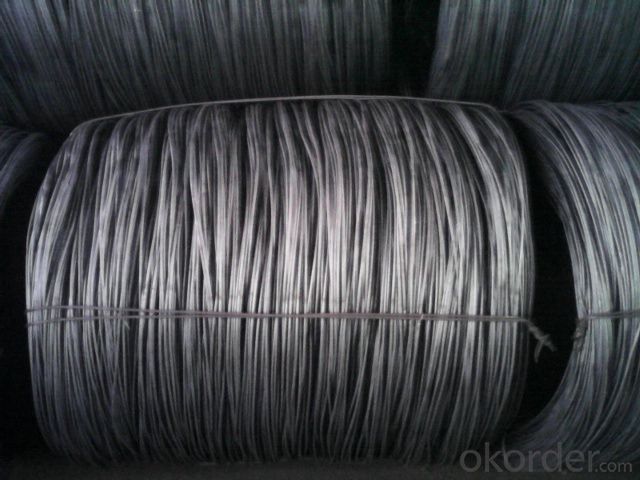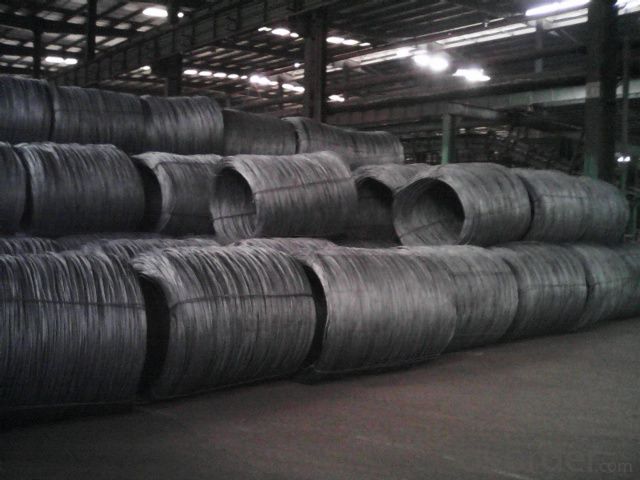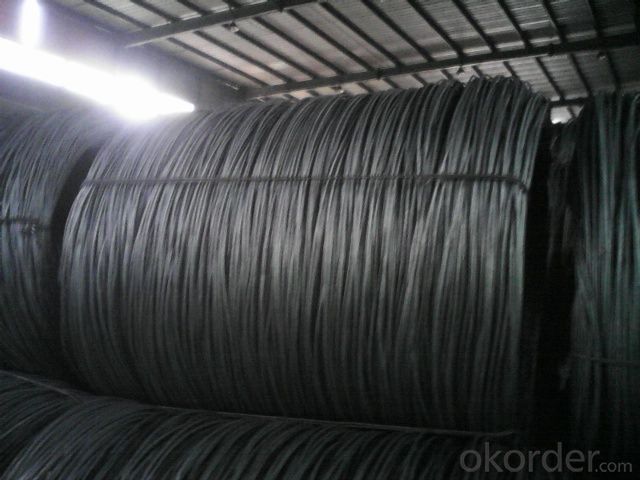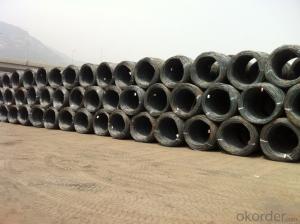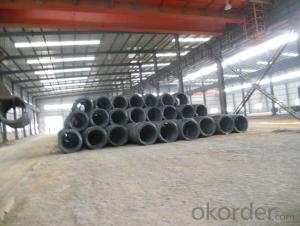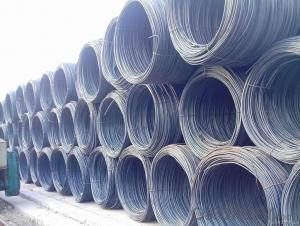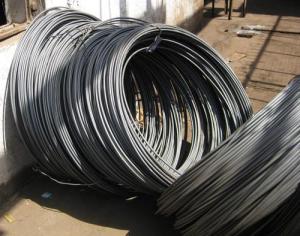Hot Rolled Steel Wire Rods SAE1006Cr---SAE1018Cr
- Loading Port:
- Tianjin
- Payment Terms:
- TT OR LC
- Min Order Qty:
- 25 m.t.
- Supply Capability:
- 200000 m.t./month
OKorder Service Pledge
OKorder Financial Service
You Might Also Like
Specification
Product Description:
OKorder is offering Hot Rolled Steel Wire Rods SAE1006Cr---SAE1018Cr at great prices with worldwide shipping. Our supplier is a world-class manufacturer of steel, with our products utilized the world over. OKorder annually supplies products to African, South American and Asian markets. We provide quotations within 24 hours of receiving an inquiry and guarantee competitive prices.
Product Applications:
Hot Rolled Steel Wire Rods SAE1006Cr---SAE1018Cr are ideal for structural applications and are widely used in construction and manufacturing. Carbon steel wire rod is mainly used for reinforcement of reinforced concrete and welded structure or reprocessed (roberts , nail, etc.) materials, especially used to produce wire drawing, welding electrode, nails, spring, electronic, precise machinery parts and so on.
Product Advantages:
OKorder's Hot Rolled Steel Wire Rods SAE1006Cr---SAE1018Cr are durable, strong, and wide variety of sizes. They are newly produced by good quality steel billets.
Main Product Features:
· Premium quality
· Prompt delivery & seaworthy packing (30 days after receiving deposit)
· Can be recycled and reused
· Mill test certification
· Professional Service
· Competitive pricing
Product Specifications:
Steel Grade: SAE1006-1018B
Standard: ASTM, GB
Diameter: 5.5mm, 6.5mm, 7mm,8mm,9mm,10mm,12mm,14mm
Type: in coil, coil weight around 2MT
Alloy or Not: Alloy
Technique: Hot Rolled
Place of Origin: China Mainland
Surface: round, no twisted, light and smooth
FAQ:
Q1: Why buy Hot Rolled Steel Wire Rods SAE1006Cr---SAE1018Cr from OKorder.com?
A1: All products offered byOKorder.com are carefully selected from China's most reliable manufacturing enterprises. Through its ISO certifications, OKorder.com adheres to the highest standards and a commitment to supply chain safety and customer satisfaction.
Q2: How do we guarantee the quality of our products?
A2: We have established an advanced quality management system which conducts strict quality tests at every step, from raw materials to the final product. At the same time, we provide extensive follow-up service assurances as required.
Q3: How soon can we receive the product after purchase?
A3: Within three days of placing an order, we will arrange production. The normal sizes with the normal grade can be produced within one month. The specific shipping date is dependent upon international and government factors, the delivery to international main port about 45-60days.
Images:
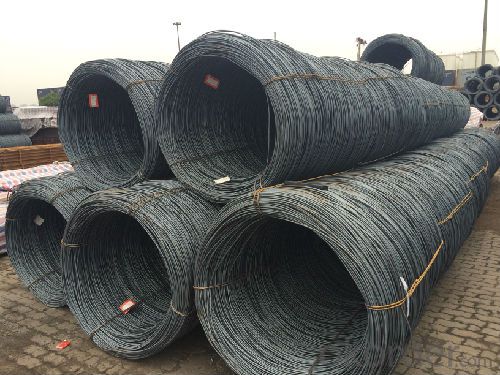
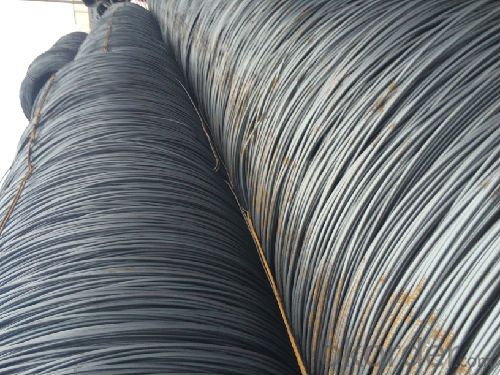
- Q: What are the different types of wire mesh made from steel wire rod?
- There are several different types of wire mesh that are made from steel wire rod. Some of the most common types include: 1. Welded Wire Mesh: This type of wire mesh is made by welding the steel wire rods together at the intersections, forming a grid pattern. It is often used for fencing, security enclosures, and reinforcement in concrete structures. 2. Woven Wire Mesh: This type of wire mesh is created by weaving the steel wire rods together in an interlocking pattern. It is available in different weave styles, such as plain weave, twill weave, and Dutch weave. Woven wire mesh is commonly used for filtration, screening, and separation applications. 3. Expanded Metal Mesh: This type of wire mesh is made by cutting and stretching the steel wire rods, creating a mesh with diamond-shaped openings. Expanded metal mesh is lightweight, strong, and versatile, making it suitable for various applications, including walkways, security grilles, and decorative panels. 4. Perforated Metal Mesh: This type of wire mesh is produced by punching holes into the steel wire rods, creating a pattern of openings. Perforated metal mesh is often used for architectural purposes, such as facades and sunscreens, as well as for filtration, ventilation, and acoustic control. 5. Knitted Wire Mesh: This type of wire mesh is made by knitting the steel wire rods together, forming a flexible and resilient structure. Knitted wire mesh is commonly used for gaskets, seals, and filtration applications, as it can provide high levels of gas and liquid filtration. These are just a few examples of the different types of wire mesh that can be made from steel wire rods. Each type has its own unique characteristics and applications, making them suitable for a wide range of industrial and commercial purposes.
- Q: What are the common production processes for chromium-coated steel wire rod?
- The common production processes for chromium-coated steel wire rod include surface preparation, coating application, curing, and finishing. Surface preparation involves cleaning and removing any impurities from the steel wire rod to ensure proper adhesion of the chromium coating. The coating application is typically done through electroplating or electroless plating methods, where a layer of chromium is deposited onto the surface of the wire rod. The coated wire rod is then cured through a heat treatment process to enhance the hardness and durability of the chromium coating. Finally, finishing processes such as polishing or grinding may be carried out to achieve the desired surface smoothness and appearance.
- Q: What are the main factors influencing the choice of steel wire rod order payment method?
- The main factors influencing the choice of steel wire rod order payment method can vary depending on the specific circumstances and preferences of the parties involved. However, some common factors that often come into play include: 1. Transaction volume and frequency: If the buyer and seller have a long-term and high-volume relationship, they may opt for a more convenient and efficient payment method such as open account or letter of credit. This allows for smoother and quicker transactions without the need for repetitive paperwork or bank involvement. 2. Trust and creditworthiness: If there is a lack of trust between the buyer and seller, or if the buyer's creditworthiness is questionable, the seller may prefer more secure payment methods such as advance payment or documentary collection. These methods provide a level of assurance that the payment will be made before the goods are delivered. 3. Cost and convenience: The cost and convenience of different payment methods can also influence the choice. For instance, if the buyer wants to avoid additional fees or charges associated with certain payment methods, they may opt for methods like cash in advance or electronic funds transfer. On the other hand, if the seller wants to minimize the administrative burden or costs of payment processing, they may prefer open account or electronic payments. 4. Country-specific regulations and customs: Different countries have their own regulations and customs when it comes to international trade and payment methods. For example, certain countries may have restrictions on certain payment methods or require specific documentation for customs clearance. Sellers and buyers need to consider these factors when choosing the payment method. 5. Payment security and risk mitigation: The level of payment security and risk mitigation desired by the buyer and seller can also influence the choice of payment method. Methods such as letter of credit or documentary collection provide a higher level of security and risk mitigation compared to methods like open account or cash in advance. 6. Market norms and industry practices: The prevailing market norms and industry practices may also influence the choice of payment method. For instance, in certain industries or regions, it may be common to use specific payment methods due to historical practices or preferences. In conclusion, the main factors influencing the choice of steel wire rod order payment method include transaction volume and frequency, trust and creditworthiness, cost and convenience, country-specific regulations and customs, payment security and risk mitigation, as well as market norms and industry practices. It is essential for both the buyer and seller to carefully evaluate these factors to select the most suitable payment method for their specific situation.
- Q: How are steel wire rods packaged and shipped?
- Steel wire rods are typically packaged and shipped in coils or bundles. The rods are tightly wound into coils, secured with steel straps or wire ties, and then wrapped in protective materials such as plastic or paper. These coils are then loaded onto pallets or into crates for transportation. Alternatively, smaller diameter rods may be bundled together with steel straps or wire ties and packaged in wooden crates or steel frames. Once packaged, the steel wire rods are shipped using various modes of transportation, including trucks, trains, and ships, depending on the distance and destination.
- Q: What are the common surface treatments for steel wire rod?
- There are several common surface treatments for steel wire rods. These treatments are applied to enhance the appearance, durability, and corrosion resistance of the wire rods. One common surface treatment is galvanization. Galvanization involves coating the steel wire rod with a layer of zinc. This zinc coating acts as a barrier between the steel and the environment, protecting it from rust and corrosion. Galvanized steel wire rods are often used in outdoor applications or in environments where moisture and harsh conditions are present. Another common surface treatment is phosphating. Phosphating involves applying a phosphate coating to the steel wire rod. This coating improves the adhesion of subsequent coatings or paints, making it an ideal surface treatment for wire rods that will be further processed or painted. A third common surface treatment is powder coating. Powder coating involves applying a dry powder to the steel wire rod and then curing it under heat. This process creates a durable and attractive finish that is resistant to chipping, scratching, and fading. Powder coating is commonly used in applications where aesthetics and durability are important, such as furniture, automotive parts, and appliances. Additionally, steel wire rods can also undergo processes like pickling, where the rod is immersed in an acid solution to remove any scale or impurities on the surface, or electroplating, where a thin layer of metal is deposited onto the wire rod to enhance its appearance and corrosion resistance. Overall, the choice of surface treatment for steel wire rods depends on the specific requirements of the application. By selecting the appropriate surface treatment, the steel wire rod can be protected and enhanced to meet the desired performance and aesthetic standards.
- Q: What are the common applications of galvanized steel wire rod?
- Due to its unique properties and benefits, galvanized steel wire rod finds wide-ranging applications in various industries. Below are some examples of how it is commonly used: 1. In the construction industry, galvanized steel wire rods are extensively employed to reinforce concrete structures such as beams, columns, and foundations. The galvanized coating provides resistance to corrosion, making it suitable for outdoor applications where exposure to moisture and harsh weather conditions is common. 2. For manufacturing fences, wire mesh, and barriers, galvanized steel wire rod is commonly used. The galvanized coating enhances the wire's durability and makes it rust-resistant, ensuring a longer lifespan even in outdoor environments. 3. The automotive industry also utilizes galvanized steel wire rods for various applications. These rods are used in the manufacturing of automotive parts like springs, suspension systems, and brake cables. The galvanized coating provides protection against corrosion, ensuring the longevity and reliability of these components. 4. In the agricultural sector, galvanized steel wire rods are extensively used for making wire fences, trellises, and supports for plants and crops. The galvanized coating protects the wire from rusting, ensuring its durability in agricultural environments that are often exposed to moisture and chemicals. 5. Galvanized steel wire rods are also employed in electrical applications, such as the manufacturing of electrical wires, cables, and conductors. The galvanized coating provides an additional layer of protection against corrosion, ensuring the safety and longevity of electrical installations. 6. The packaging and binding industry also benefits from the use of galvanized steel wire rods. These rods are utilized for making wire ties, baling wire, and various packaging materials. The galvanized coating provides strength and durability, making it ideal for securing and bundling different materials. These examples demonstrate just a few of the common applications of galvanized steel wire rod. Its versatility, strength, and corrosion resistance make it a valuable material in numerous industries and sectors.
- Q: How is steel wire rod used in the production of nails and fasteners?
- Nails and fasteners heavily rely on steel wire rod, a fundamental element in their manufacturing process. Serving as the main raw material, it grants the necessary strength and durability to these items. To create nails and fasteners, steel wire rod undergoes a series of carefully planned procedures. Initially, it is heated and rolled into a coil shape, enhancing its ductility and reducing its thickness. This procedure, known as hot rolling, imparts the wire rod with the essential properties required for subsequent manipulation. Following hot rolling, the wire rod goes through cold drawing, where it is pulled through a set of dies to further decrease its diameter. This process not only improves the wire's surface finish but also enhances its mechanical properties, including tensile strength and hardness. Upon completion of cold drawing, the drawn wire is cut into specific lengths, depending on the desired size of nails or fasteners. These lengths are then fed into either a nail making machine or a fastener production line. In the case of nails, the wire is passed through a cutter that shapes the nail heads and points. Conversely, for fasteners, the wire is molded and formed into the desired product, such as screws, bolts, or rivets. The quality of the steel wire rod utilized in the production of nails and fasteners is of utmost importance for the performance of the end products. It must possess exceptional tensile strength, as nails and fasteners are subjected to significant stresses during use. Moreover, the wire rod needs to exhibit corrosion resistance, ensuring that the nails and fasteners can endure exposure to moisture and other environmental conditions without deterioration. All in all, steel wire rod assumes a crucial role in the production of nails and fasteners, providing the indispensable strength, durability, and corrosion resistance necessary for these essential commodities.
- Q: What are the main factors influencing the choice of steel wire rod order replacement policy?
- The main factors influencing the choice of steel wire rod order replacement policy include the current inventory levels, demand forecasting accuracy, lead time for procurement, production capacity, and customer requirements. Additionally, factors such as cost considerations, market conditions, and supplier reliability also play a significant role in determining the replacement policy for steel wire rod orders.
- Q: How is steel wire rod used in the manufacturing of wire racks?
- Steel wire rod is a crucial component in the manufacturing of wire racks as it serves as the primary material used to create the framework and structure of the rack. The wire rod is initially processed through a series of steps such as heating, rolling, and drawing to transform it into a thin, long, and continuous wire. This wire is then bent, shaped, and welded to form the different parts of the wire rack, including the sides, shelves, and supports. The high tensile strength and durability of steel wire rod make it an ideal choice for wire racks as it can bear heavy loads and withstand constant use without bending or breaking. Additionally, the steel wire rod's corrosion resistance properties ensure that the wire racks remain sturdy and long-lasting, even in environments with high humidity or exposure to moisture. The versatility of steel wire rod allows manufacturers to create wire racks in various sizes and designs to cater to different storage needs. The wire rod can be easily manipulated to form different shapes, allowing for the creation of wire racks with adjustable shelves or collapsible features. This flexibility in design makes wire racks highly customizable and adaptable for use in various settings, such as homes, offices, warehouses, or retail stores. Furthermore, the use of steel wire rod in wire rack manufacturing enables efficient production processes. The wire rod can be easily cut, shaped, and welded using automated machinery, reducing production time and costs. This ease of manufacturing also allows for mass production of wire racks, ensuring a steady supply to meet market demands. In conclusion, steel wire rod plays a vital role in the manufacturing of wire racks by providing the necessary strength, durability, and versatility required for these storage solutions. Its ability to be easily shaped, resistance to corrosion, and cost-effectiveness make it an ideal material for creating wire racks of various sizes and designs.
- Q: What are the different types of steel wire rod surface cleaning chemicals?
- In industrial applications, various types of chemicals are commonly utilized to clean the surface of steel wire rods. These chemicals serve the purpose of eliminating dirt, rust, scale, and other impurities from the rods, ensuring their cleanliness and suitability for further processing or utilization. The most prevalent varieties of cleaning chemicals for steel wire rod surfaces are as follows: 1. Acidic cleaners: Hydrochloric acid or sulfuric acid are frequently employed as acidic cleaners to eradicate rust and scale from steel wire rods. These cleaners function by dissolving the rust and scale, resulting in a clean and smooth surface. 2. Alkaline cleaners: Sodium hydroxide or potassium hydroxide-based alkaline cleaners are effective in eliminating grease, oil, and other organic contaminants from steel wire rods. These cleaners work by breaking down and emulsifying the oils and greases, facilitating easy rinsing. 3. Solvent-based cleaners: Mineral spirits or acetone are commonly used as solvent-based cleaners to remove stubborn stains or adhesive residues from steel wire rods. These cleaners work by dissolving the stains or residues, making it easier to wipe or rinse them away. 4. Pickling solutions: Pickling solutions, which typically consist of acid and surfactants, are utilized to eliminate oxides and other surface impurities from steel wire rods. These solutions function by chemically reacting with the impurities, enabling their easy removal. 5. Passivating agents: Nitric acid or citric acid-based passivating agents are employed to remove surface contaminants and facilitate the formation of a protective oxide layer on the surface of steel wire rods. This oxide layer helps prevent corrosion and prolongs the lifespan of the steel. It is crucial to consider the specific requirements and condition of the steel wire rods when selecting a cleaning chemical. Furthermore, it is essential to adhere to proper safety precautions and guidelines to ensure the safety of workers and prevent any environmental damage while handling and using these chemicals.
Send your message to us
Hot Rolled Steel Wire Rods SAE1006Cr---SAE1018Cr
- Loading Port:
- Tianjin
- Payment Terms:
- TT OR LC
- Min Order Qty:
- 25 m.t.
- Supply Capability:
- 200000 m.t./month
OKorder Service Pledge
OKorder Financial Service
Similar products
Hot products
Hot Searches
Related keywords



